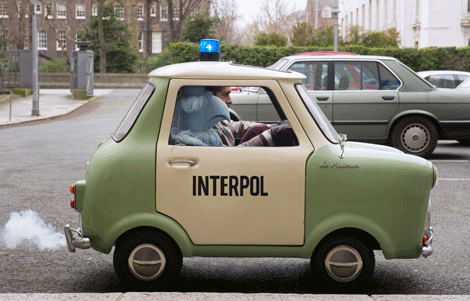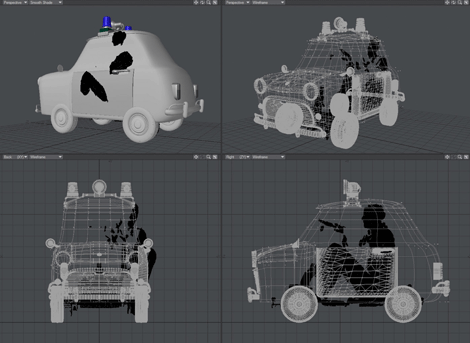
The Interpol car from Muppets Most Wanted evolved as the team from Propshop worked with the Muppet’s art team
Special effects is a wonderfully diverse industry, where else could you be crating warrior armour and weapons one day, then sculptures of footballers the next?
Propshop is one such company in the relatively small and interconnected world of effects, and most recently it’s been working on Disney Muppets movie, Muppets Most Wanted.
Charged with the task of creating a functional yet zany car to be driven by Interpol Agent Jean Pierre Napoleon, played by Actor Ty Burrell, the waist-high car is seen zipping through various scenes as the agent attempts to track down the notorious Constantine, who bears an uncanny resemblance to Kermit the Frog.
//www.youtube.com/embed/DQiGyBiNjLI
Located at Pinewood Studios, Propshop specialises in the design and manufacture of hero props, set pieces, costumes, models, and miniatures using a combination of LightWave 3D and 3D printing.
We got in touch with the team at Propshop, including Jet Cooper, 3D supervisor in the digital department, to discusses how they created these unique props for the film:
When did you start creating props?
Propshop has been making props for more than 15 years. I started using LightWave some 20 years ago – since the days of the Amiga, back when LightWave came on 10 floppy disks, in Version 3.5. When I joined the company a few years ago, LightWave became part of the process.
One of our first pieces using LightWave was Cerebro for X-Men: First Class. Since then, we have used LightWave to generate our 3D [imagery] for over 30 movies and productions.
Why did you select LightWave?
LightWave is fast, intuitive, and a ‘no-mess’ modeling package. Here at Propshop, we have built a strong and successful pipeline with LightWave as a foundation.
How is LightWave used in your prop creation?
I use LightWave to build all my 3D models before they go to print. LightWave is also used in the designing/concepting process, with its renderer being utilized for animations to explain a prop’s form, function, and final look. The Modeler is fast and capable of achieving models that are organic, hard-surfaced, and extremely complex. Propshop has been able to create anything with the LightWave Modeler.

The car designs were modeled with LightWave 11 and polished with Pixologic’s ZBrush when and where required
Let’s talk about the car. Was the design based on an actual vehicle?
The design of the car was originally based on an old Russian car. However, this changed to a completely different hybrid over the course of the project. There were different versions that evolved as we corresponded with the movie’s art department. As reference, the Muppet art department provided a few photos of Russian cars and some sketches suggesting the form they had in mind.
Which tools did you use to create the vehicle?
The car designs were modeled with LightWave 11 and polished with Pixologic’s ZBrush when and where required.
What kind of challenges did you face?
The challenge is always to satisfy the vision of the director and art department while producing a model that can be manufactured in a working and practical form.
Were there many design iterations?
There were six car types including the final choice.
How was LightWave used in the car creation process?
The car was modeled using subdivision surfaces and concept artwork. The 3D car was then frozen to make a high-resolution poly mesh that could be exported to produce a ‘water-tight,’ printable STL file that is used by our 3D printers.
This is a large prop. Can you provide some details about the file and the prep work required to 3D print it?
The car was separated into pieces that were then further digitally cut to fit our large printing beds – for example, the main body of the car, bonnet, trunk, doors, headlight assembly, and so forth. The file sizes ranged between a few megabytes up to a few hundred megabytes. These file sizes are larger due to the fact that the planes in the geometry have to be small enough to look smooth when printed in 3D. The more organic or detailed the subject, the larger the file has to be in order to produce good results on Propshop’s high-resolution printers.
Why do you use 3D printing as part of the manufacturing process?
3D printing allowed us to generate a design that could be adjusted and modified on the fly, whereas the traditional methods take longer and are harder to change as problems and needs arise. It also makes sense that once we have nailed the artwork, we use that signed-off model to produce the actual hero prop. That way, there is no deviation from what the art department and director have seen and approved.
Prior to 3D printing, how would this have been done?
Originally, we would have used traditional model-making methods of the past and sculpted clay body parts, then produced molds for fiberglass.
How has 3D printing evolved to enable you to create props like you do?
3D printing has become faster, and the volume is larger so that larger-size parts can be printed as a whole. Our large 3D prints can now range up to 1.6 meters per piece and print overnight! Our printers now recycle non-used material, thus reducing costs and waste.
What kind of 3D printer do you use?
We primarily used Voxeljet printers, which lay down a fine plastic powder and binding agent. The end result is a strong print that can be tooled and finished in many different ways.
Was size an issue when it came time to printing the vehicle?
The size of the car wasn’t an issue – we have printed much larger things before, such as an entire spacecraft. We just cut any oversize parts into pieces and join them upon assembly.
Which pieces of the vehicle were 3D printed?
The body and accessories, such as headlights and so forth.
How many pieces of the car did you have to output?
The car comprises seven 3D printed main parts.
What were some of the overall challenges of building this particular object?
The overall challenge was first getting everyone involved to settle on the end look. Once this was done, the next biggest challenge was meeting the needs of the movie and script. The car had to fit atop a stripped-down golf buggy [and accommodate] an actor and a puppeteer.
This was achieved by laser-scanning the buggy, which enabled us to fit our LightWave model over the existing chassis data.
We then scanned one of our staff sitting in the golf buggy so we could then check for sizing issues and tackle the problem of fitting the actor in the passenger seat.
This process also allowed us to work out how and where the puppeteer would be positioned.

The 3D car was frozen to make a high-resolution poly mesh that could be exported to produce a ‘water-tight,’ printable STL file
It’s a functioning vehicle – how did that affect your design and creation processes?
Almost all our props and hero props have to either function or withstand physical abuse on set. For the car, the body had to be strong. The body had to fit and bolt onto the existing host chassis. The panels had to function like a real car and be smooth enough to hold an automotive finish.
When modeling, we had to be mindful of scale, tolerances, and how it would be assembled.
Did you create any other props for this movie?
We created a range of other props for the movie, such as the bust of Ricky Gervais that hides a key. But, my personal favorite is the CIA versus FBI badge gag.
We modeled a standard CIA and FBI badge from reference photos. These were then scaled up and 3D printed. Sam Eagle pulls out a plaque-size badge to outdo the FBI agent’s regular shield.
The FBI agent then opens his shirt to display a larger, chest-size badge. Sam responds with a six-foot CIA shield to trump the FBI – special delivery!
Which other recent films have you worked on?
We have worked on Maleficent, Guardians of the Galaxy, and are currently working on an epic science-fiction movie.
What are some of the more unusual props you have created?
After being in the film industry as long as Propshop has been, nothing strikes us as unusual anymore. Creatures, artifacts, weapons…. It’s all in a day’s work.
How does LightWave help you to achieve your goals?
The crucial factor is LightWave’s speed, which is a primary consideration in the film industry. The Modeler is dependable, with stable, predictable results, and output that other parts of our pipeline can use. LightWave is also a ‘complete’ package, which not only generates high-end models, but can be harnessed to produce polished renders and animations that are vital to getting work signed off and to expressing ideas.
Which version of LightWave are you using?
We use the current version, 11.6
What type of computer is LightWave running on at Propshop?
We use a combination of 64GB HP Z620 and Z820 workstations, which have proven to be fast and stable under huge workloads. The HP workstations are fitted with Nvidia Quadro 4000 and 6000 graphics cards.
At Propshop, what other software do you use?
We use Maya, ZBrush, Modo, KeyShot, Photoshop, Illustrator, and many more.
What does LightWave let you do that other software does not?
All hammers can drive in a nail – I chose the LightWave brand of hammer because it has been around for a long time. It hits the nail straight and works well for me…it’s a proven tool of choice.






